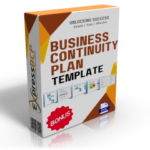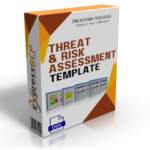In today’s unpredictable world, having a robust Business Continuity Plan (BCP) is essential for organizations of all sizes. A well-crafted BCP ensures that your business can continue to operate during and after a disaster. This post will cover the basics of a business continuity plan, including its importance, key components, and steps to develop an effective plan.
What is a Business Continuity Plan?
A Business Continuity Plan is a strategic approach that outlines the procedures and instructions an organization should follow in the face of disaster. These disruptions could be anything from natural disasters, cyber-attacks, or pandemics, to operational interruptions like power outages or equipment failures.
Why is a Business Continuity Plan Important?
1. Minimizes Downtime: A well-structured BCP ensures that critical business functions can continue with minimal interruption, preserving revenue and customer trust.
2. Protects Reputation: Continuity in operations helps maintain your business’s reputation. Clients and stakeholders appreciate resilience and reliability.
3. Compliance Requirements: Regulatory bodies such as FINRA (Financial Industry Regulatory Authority), APRA (Australian Prudential Regulation Authority) and PRA/BOE (Prudential Regulation Authority/Bank of England) mandate robust continuity planning for financial sectors, as such do numerous other industries.
Understanding potential risks and their impacts is the foundation of any BCP.
A Business Impact Analysis (BIA) and Risk Assessment are critical steps in business continuity planning. Together, they help a company identify and prioritize its most important operations and the risks that could disrupt them.
Business Impact Analysis (BIA): The BIA focuses on understanding which parts of your business are most essential to keep running. It identifies key processes, like sales, customer support, or production, and assesses the impact if these were interrupted—financially, legally, or reputationally. The goal is to determine how quickly these processes need to be restored after a disruption to minimize damage.
Risk Assessment: The risk assessment identifies potential threats (like cyberattacks, natural disasters, or equipment failures) that could impact those critical processes. It evaluates the likelihood of these risks happening and the severity of their consequences. The goal is to prioritize which risks need immediate attention and mitigation.
Together, the BIA and risk assessment provide a roadmap for focusing your efforts on protecting and recovering the most important areas of your business.
Developing an Effective Business Continuity Plan
Time tested and proven steps for successful business continuity plan creation and maintenance:
- Identifying Threats:
Review threats and risks that are relevant to your operations. Natural disasters, cyber threats, supply chain disruptions, etc.
Assessing Vulnerabilities: Evaluating weaknesses in your current systems and processes. - Conducting a Business Impact Analysis (BIA)
Determining the effects of disruptions on critical business operations.
- Recovery Strategies
Based on the BIA, develop strategies to recover and maintain operations. These strategies should address:
– Critical Business Functions: Prioritize functions that are essential to your business’s survival.
– Recovery Time Objectives (RTO): Set timeframes within which functions must be restored.
– Resources and Personnel: Identify the necessary resources and personnel required for recovery. - Business Continuity Plan Development
This involves creating a comprehensive document that outlines:
– Roles and Responsibilities: Clear details of key accountabilities and actions of stakeholders.
– Emergency Response Procedures: Steps to ensure immediate safety and initial response.
– Communication Plans: Clear communication channels for internal and external stakeholders.
– IT Disaster Recovery: Detailed plans to recover and restore IT systems and data - Training and Testing
A BCP is only as good as its implementation. This involves:
– Employee Training: Regular training sessions to ensure all employees understand their roles in the BCP.
– Testing and Drills: Conduct regular tests and drills to identify gaps and improve the plan.
Best Practices for Successful Business Continuity Management
Creating a strong Business Continuity Management Program involves getting the basics right. First, secure support from senior leadership to ensure resources and enforcement. Keep communication clear so everyone stays informed. Regularly update the plan to reflect new risks and changes. Include key suppliers to ensure they can support you during disruptions. Finally, align your BCP with industry standards and regulatory requirements for compliance and effectiveness
- Top Management Support: Ensure senior leadership is committed to the BCP process. Their support is crucial for resource allocation and policy enforcement.
- Clear Communication: Maintain clear and open communication channels. This ensures everyone is informed and aligned with the plan.
- Regular Updates: Continuously review and update the BCP to reflect new risks, technologies, and business changes.
- Supplier Management: Include key suppliers and partners in your BCP to ensure they can support your operations during a disruption.
- Compliance and Standards: Align your BCP with industry standards such as ISO 22301 and regulatory requirements like APRA 230 and PRA/BOE guidelines.
Its just a matter of time until you are in the middle of a crisis
A Business Continuity Plan is not a luxury; it’s a necessity for any business aiming for resilience and long-term success. By understanding the basics of a BCP and implementing a structured approach to planning, you can ensure your business is prepared to face any challenge. Remember, the key to a successful BCP is continuous improvement, testing, and adaptation to the ever-changing risk landscape.
Ready to create a great business continuity plan?
Are you ready to secure your business’s future? Start developing your Business Continuity Plan today and ensure your operations are resilient against any disruption. For more insights and resources on business continuity planning, visit our other blog articles.







